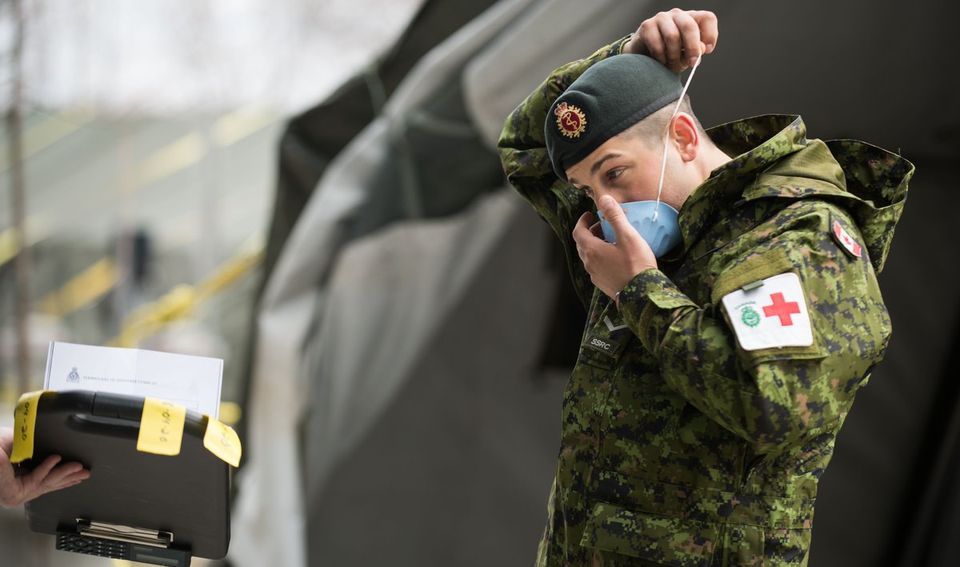Tim Heffernan and Jim Sugiyama
Cockroaches, rotten food, patients with ulcers left bed-bound, staff moving from unit to unit wearing contaminated gear, staff afraid to ask for supplies for fear of increasing the costs to the home. Those were just some of the disturbing conditions detailed in a Canadian Armed Forces report based on the observations of its members at five Ontario long-term care homes deemed by the province to have required the most support. Over 1,675 troops were brought in to backstop these homes in the last week of April. The allegations paint an appalling picture of residents being bullied, drugged, and left for hours and days in soiled bedding. Of the five homes in question, four were for-profit institutions and the other was a Christian not-for-profit.
The situation in the homes must have been appalling to make soldiers, trained for war, express their horror and there must have been immense internal pressure from the soldiers up the command chain, for the Armed Forces to produce the report.
No surprise
Few people were surprised. The revelations about Ontario’s long-term care homes (LTCH) read as the chronicle of a disaster foretold. As 80% of the COVID-19 deaths, over 1,600 people, in Ontario came from the seniors’ population and a substantial number of those could be found in the LTCHs, it was inevitable that the spotlight would focus on these homes. A month ago, on this website, in an article on Ontario LTHC, we wrote “due to cost-cutting and profit gouging, the seniors’ homes became death traps.” But how did it get to that situation? It’s not as if it came as surprise to government officials. It was 17 years ago that The Toronto Star produced an in-depth investigation into long-term care. “Over 10 days, the newspaper published a series that combined data and personal stories, to expose a system in despair. People were left in filthy diapers. They lost the ability to walk because nobody would lend a steady arm. Police investigated a pressure ulcer that had rotted with gangrene.”
Revolution
“It made Ontario’s new health minister George Smitherman cry. He even promised a revolution. The series ultimately led to new legislation and ministry oversight that was supposed to end the cosy relationship between inspectors who called in advance, so homes could pretty up the residents before inspection day arrived.” But little else changed. Over the years, The Star published stories that “exposed a systemic disinterest in older people. A woman with a broken femur was given Tylenol for her pain, as if age meant she didn’t feel the throbbing. Another woman choked to death on a ‘restraint’ that locked her into a chair, and it took some time before the home called the coroner.” In 2011, The Star examined the new, tougher inspection system to see what it had uncovered. “The same stories emerged. Neglect, abuse, and this time, rape, although the public report didn’t characterize it quite so bluntly. Only the homes’ internal reports saw the straight language inspectors used. The public reports were sanitized. All along, health ministers in charge of Ontario’s long-term care homes, where 77,000 people live, promised change. No more abuse, they’d say. We will fix the system. Ontario is better than this.”
Rot sets in – Tories and Liberals
But they didn’t fix the system. One could argue that the rot began with Mike Harris, Tory Premier of Ontario in the 1990s, who had a lasting impact on long-term care when his government oversaw the expansion of private ownership in a sector short on regulations and standards. Harris, having spearheaded for-profit ownership back then, now profits handsomely from it himself. Today, as chair of Chartwell Retirement Residences, the former premier presides over a sprawling operation that describes itself as “the largest retirement living company in Canada.”
But the problem goes beyond Harris. The Rank and File website recently ran a story titled “Ontario PCs (Conservatives) aren’t alone: Exposing Liberal ties with corporate long-term care lobby.” They made the point that during the long Liberal era in Ontario (2003-2018), former Liberal insiders were also employed as lobbyists for the Ontario Long-Term Care Association. Furthermore, “it’s no secret there is a revolving door between industry and government. Political staffers can leverage their understanding of government operations to establish lobbying careers, typically advocating for profit-driven business interests.”
Profits, private lobbying, staffing and lack of regulation
Only nine out of 626 homes in Ontario actually received so-called resident quality inspections last year. A review of inspection reports of all the province’s long-term care homes found that most received a comprehensive resident quality inspection in 2015, 2016 and 2017. Then the number dropped to just over half in 2018 and just nine last year. The explanation is lobbying from the care home industry and government cuts. The National Post revealed “The companies managing long term care homes where the military found rotting food, cockroaches, patients in soiled beds and conditions that allowed COVID-19 to spread, also run dozens of other facilities in the province and have made millions of dollars a year operating them.”
Those millions are now under threat. One of the companies facing indictment, Sienna Senior Living, raised the issue of staffing to their investors, fully aware that pressure is building up to hire more Personal Support Workers (PSWs) at increased pay. In a note to investors earlier this month, the company’s management said staffing could affect profitability going forward. “Any shortage of qualified personnel and general inflationary pressures may require the company to enhance its pay and benefits package to compete effectively. An increase in labour-related costs or a failure to attract, train and retain qualified and skilled personnel may have a material adverse impact on the business, operating results and financial condition of the company.”
The four profit driven care homes that the Army was sent to are:
- Altamont Care Community owned by Sienna Senior Living, which made a $7.5-million profit in 2019
- Orchard Villa owned by Southbridge Care Homes, which does not publicly report its accounts and managed by Extendicare, made $28.6 million profits in 2019
- Hawthorne Place Care Centre and Eatonville Care Centre are operated by Rykka Care Centres, which doesn’t publicly report its financial returns
It is outrageous that these companies do not report their profits. Based on those that do, it is clear there is lot of money to be made from elder abuse.
It’s a scandal that it took the deployment of military personnel and the report that they produced for the story to blow up and elicit responses from both Doug Ford and Justin Trudeau. Ford reacted to the report: “It’s heartbreaking, horrific, it’s shocking that this can happen here in Canada. It’s gut-wrenching, and reading those reports is the hardest thing I’ve done as premier.” He added, “There’s going to be justice. There’s going to be accountability.” Fine words that we have heard before from Mr. Ford who announced his government will be launching an independent commission into Ontario’s long-term care system beginning in September. The health care unions and the NDP correctly claim a government commission can be neither truly independent, nor effective. Instead they call for a full public inquiry. Yet whether it’s a commission or an inquiry, there is a strong tenor of blame falling on the frontline workers themselves for the deplorable conditions seen in homes. This is indicated by Ford trying to deflect responsibility for the long-term failures of his and previous governments by blaming inspectors. Ford does not mention that it was his government that slashed inspections of homes from hundreds every year up until 2017 to just nine in 2019.
The five care homes that needed the army were only the worst of a bad bunch. Around half of all Ontario’s care homes had COVID-19 outbreaks and close to a hundred had deaths, with for-profit facilities having a death rate nearly three times that of municipally owned homes. On April 10, after 33 deaths in long-term care, BC took all care home workers into the public sector with union wages, full time contracts and a ban on working in more than one home. To this day, with over 1,600 care home deaths, Doug Ford refuses to take this life-saving action.
Regular inspections, while welcome, won’t be enough. The concern is that the anvil is going to fall on people like PSWs and not the greedy owners who are truly responsible for the conditions in individual homes. Lack of adequate PPE, no time to feed people, bug infestations and failing to change diapers are wholly the result of a system that encourages profit over care. We must ensure that the real villains are brought to book and the profit system is ended.
Socialist Alternative Canada says:
- Fight the cuts – restore full funding to hospitals and long-term care homes.
- Fight Privatization – no 2-tier health service.
- End private, for-profit care homes; bring all into public ownership and control, with compensation only to those in need, not to enrich the owners.
- Prosecute the owners for the needless deaths.
- Immediately raise the wages of all care home workers to union rates of pay.
- Support the struggle for decent, unionized, well paying jobs in hospitals and care homes, including guaranteed steady hours in only one institution.
- For a socialist society, one that can provide dignified care and treatment for the elderly.


